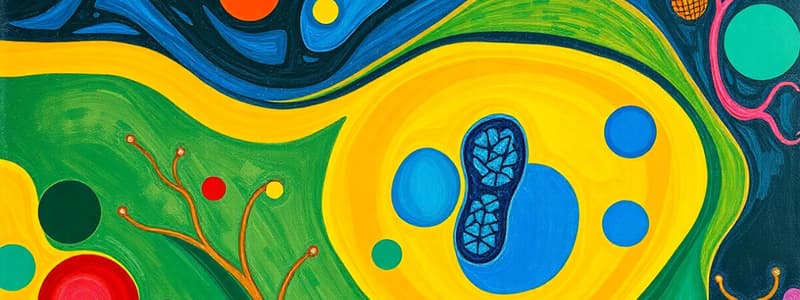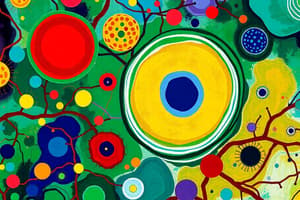Podcast
Questions and Answers
Who proposed the hierarchical 'Great Chain of Being'?
Who proposed the hierarchical 'Great Chain of Being'?
- Antonie van Leeuwenhoek
- Empedocles (correct)
- Robert Hooke
- Charles Darwin
What significant observation did Antonie van Leeuwenhoek make in 1674?
What significant observation did Antonie van Leeuwenhoek make in 1674?
- He discovered microorganisms. (correct)
- He identified the double-helix structure of DNA.
- He described the concept of cell theory.
- He disproved spontaneous generation.
Which scientist's experiments conclusively disproved spontaneous generation in 1859?
Which scientist's experiments conclusively disproved spontaneous generation in 1859?
- John Needham
- Robert Koch
- Lazzaro Spallanzani
- Louis Pasteur (correct)
What was the fundamental principle added by Rudolf Virchow to cell theory in 1858?
What was the fundamental principle added by Rudolf Virchow to cell theory in 1858?
Which significant theory did Charles Darwin introduce in 1859?
Which significant theory did Charles Darwin introduce in 1859?
What did the work of Avery, MacLeod, and McCarty in 1944 identify as the substance responsible for heredity?
What did the work of Avery, MacLeod, and McCarty in 1944 identify as the substance responsible for heredity?
Which breakthrough in 1953 revolutionized the understanding of how life replicates?
Which breakthrough in 1953 revolutionized the understanding of how life replicates?
What did Louis Pasteur and Robert Koch develop in the 1860s?
What did Louis Pasteur and Robert Koch develop in the 1860s?
What type of asexual reproduction involves the development of an unfertilized egg into an adult animal?
What type of asexual reproduction involves the development of an unfertilized egg into an adult animal?
Which of the following terms describes animals that produce both eggs and sperm?
Which of the following terms describes animals that produce both eggs and sperm?
What is the main difference between external and internal fertilization?
What is the main difference between external and internal fertilization?
Which type of reproduction involves laying fertilized eggs outside the female's body?
Which type of reproduction involves laying fertilized eggs outside the female's body?
What is a characteristic feature of ovoviviparity?
What is a characteristic feature of ovoviviparity?
Which of the following accurately describes a food web?
Which of the following accurately describes a food web?
Regeneration in flatworms and annelids enables them to:
Regeneration in flatworms and annelids enables them to:
Which term describes organisms that have separate male and female individuals?
Which term describes organisms that have separate male and female individuals?
What does the Cell Theory state about living organisms?
What does the Cell Theory state about living organisms?
How does evolution explain diversity in life?
How does evolution explain diversity in life?
Which statement accurately describes homeostasis?
Which statement accurately describes homeostasis?
What best describes the concept of energy flow and matter cycling in ecosystems?
What best describes the concept of energy flow and matter cycling in ecosystems?
How does the structure and function principle relate to biological entities?
How does the structure and function principle relate to biological entities?
What is the significance of adaptation in organisms?
What is the significance of adaptation in organisms?
Which best encapsulates the concept of biological hierarchy?
Which best encapsulates the concept of biological hierarchy?
What major theory did Aristotle promote regarding the origin of life?
What major theory did Aristotle promote regarding the origin of life?
Which attachment style is characterized by a cold and detached caregiver?
Which attachment style is characterized by a cold and detached caregiver?
What hormonal changes primarily drive the lust stage of love?
What hormonal changes primarily drive the lust stage of love?
Which of the following best describes the anxious-ambivalent attachment style?
Which of the following best describes the anxious-ambivalent attachment style?
According to Helen Fisher, attraction is significantly influenced by:
According to Helen Fisher, attraction is significantly influenced by:
How does the propinquity effect influence attraction?
How does the propinquity effect influence attraction?
Which factor is NOT considered a strong contributor to the formation of friendships and intimate relationships?
Which factor is NOT considered a strong contributor to the formation of friendships and intimate relationships?
What does the genetic basis of loving suggest about this emotion?
What does the genetic basis of loving suggest about this emotion?
Which neurotransmitter is associated with the attraction phase of love?
Which neurotransmitter is associated with the attraction phase of love?
What is the primary function of a pang-angkop?
What is the primary function of a pang-angkop?
Which of the following is an example of konotatibo?
Which of the following is an example of konotatibo?
What type of sentence structure does a payak represent?
What type of sentence structure does a payak represent?
Which term describes the study of word meanings?
Which term describes the study of word meanings?
What is the difference between hugnayan and lanakanan structures?
What is the difference between hugnayan and lanakanan structures?
What does proxemics refer to in non-verbal communication?
What does proxemics refer to in non-verbal communication?
Which of the following provides a description of pang-ukol?
Which of the following provides a description of pang-ukol?
What role does the term 'norms' play in communication according to the content?
What role does the term 'norms' play in communication according to the content?
What aspect does chronemics focus on?
What aspect does chronemics focus on?
Which of the following is a characteristic of qualitative research?
Which of the following is a characteristic of qualitative research?
What does kinesics involve?
What does kinesics involve?
Which example represents quantitative research?
Which example represents quantitative research?
What is represented in the setting of the SPEAKING model?
What is represented in the setting of the SPEAKING model?
Which activity did Carla engage in while David was jogging?
Which activity did Carla engage in while David was jogging?
What is the primary focus of kwantitatibo research?
What is the primary focus of kwantitatibo research?
What common concern did the students have before their exam?
What common concern did the students have before their exam?
Flashcards
Cell Theory
Cell Theory
All living things are made of cells, which are the basic units of life.
Evolution
Evolution
Changes in the traits of living things over time, passed down through generations.
Genetics
Genetics
The study of heredity and inherited traits.
Homeostasis
Homeostasis
Signup and view all the flashcards
Energy Flow
Energy Flow
Signup and view all the flashcards
Interdependence
Interdependence
Signup and view all the flashcards
Structure & Function
Structure & Function
Signup and view all the flashcards
Adaptation
Adaptation
Signup and view all the flashcards
Asexual Reproduction
Asexual Reproduction
Signup and view all the flashcards
Sexual Reproduction
Sexual Reproduction
Signup and view all the flashcards
Parthenogenesis
Parthenogenesis
Signup and view all the flashcards
Hermaphroditism
Hermaphroditism
Signup and view all the flashcards
External Fertilization
External Fertilization
Signup and view all the flashcards
Internal Fertilization
Internal Fertilization
Signup and view all the flashcards
Oviparity
Oviparity
Signup and view all the flashcards
Viviparity
Viviparity
Signup and view all the flashcards
Great Chain of Being
Great Chain of Being
Signup and view all the flashcards
Four Elements Theory
Four Elements Theory
Signup and view all the flashcards
Microorganisms
Microorganisms
Signup and view all the flashcards
Spontaneous Generation
Spontaneous Generation
Signup and view all the flashcards
Biogenesis
Biogenesis
Signup and view all the flashcards
Natural Selection
Natural Selection
Signup and view all the flashcards
Avoidant Attachment
Avoidant Attachment
Signup and view all the flashcards
Anxious-Ambivalent Attachment
Anxious-Ambivalent Attachment
Signup and view all the flashcards
Lust
Lust
Signup and view all the flashcards
Attraction
Attraction
Signup and view all the flashcards
Attachment
Attachment
Signup and view all the flashcards
Pang-ukol
Pang-ukol
Signup and view all the flashcards
Reciprocity
Reciprocity
Signup and view all the flashcards
Pang-angkop
Pang-angkop
Signup and view all the flashcards
Propinquity Effect
Propinquity Effect
Signup and view all the flashcards
Pangatnig
Pangatnig
Signup and view all the flashcards
Denotative Meaning
Denotative Meaning
Signup and view all the flashcards
Connotative Meaning
Connotative Meaning
Signup and view all the flashcards
Simple Sentence
Simple Sentence
Signup and view all the flashcards
Quantitative Research
Quantitative Research
Signup and view all the flashcards
Complex Sentence
Complex Sentence
Signup and view all the flashcards
Iconics
Iconics
Signup and view all the flashcards
Chronemics
Chronemics
Signup and view all the flashcards
Qualitative Research
Qualitative Research
Signup and view all the flashcards
Compound Sentence
Compound Sentence
Signup and view all the flashcards
SPEAKING Model
SPEAKING Model
Signup and view all the flashcards
Setting (SPEAKING Model)
Setting (SPEAKING Model)
Signup and view all the flashcards
Participants (SPEAKING Model)
Participants (SPEAKING Model)
Signup and view all the flashcards
Study Notes
Unifying Themes in the Study of Life
- Basic ideas that apply to all organisms
- Connects many things in the exploration of life
Cell Theory
- All living organisms are composed of one or more cells
- The cell is the fundamental building block of life
Evolution
- Process of change in heritable characteristics of populations over successive generations
- Explains the diversity of life and how species adapt to their environments through natural selection
Genetics
- Study of heredity and the variation of inherited characteristics
- Explains how traits are passed from one generation to the next
Homeostasis
- An organism's ability to maintain a stable internal environment despite changes in external conditions
- Crucial for survival
Energy Flow and Matter Cycling
- Energy flows through ecosystems, and matter is recycled
- Energy is transformed through various processes (photosynthesis, cellular respiration)
Interdependence of Organisms
- Organisms interact with each other and their environment to form ecosystems
Structure and Function
- The structure of biological entities (cells, tissues, organs, organisms) is closely related to their function
Adaptation
- Traits that enhance an organism's ability to survive and reproduce in its environment
- Development and reproduction are crucial for species continuation
- Biological organization ranges from molecules to ecosystems, each level building on the previous
Ancient and Classical Theories (Before 1600s)
- Early civilizations believed in supernatural forces
- Aristotle's concept of spontaneous generation dominated
- Empedocles proposed life from four elements: earth, air, fire, water
Discovery of Microorganisms (1600s)
- Robert Hooke described cells observed in cork
- Antonie van Leeuwenhoek discovered microorganisms, expanding the understanding of life's diversity
Challenging Spontaneous Generation (1700s-1800s)
- John Needham supported spontaneous generation
- Lazzaro Spallanzani disputed Needham's findings, demonstrating that sterilized broth doesn't generate life
Cell Theory and Germ Theory (1800s)
- Matthias Schleiden and Theodor Schwann developed cell theory
- Rudolf Virchow added to cell theory, stating all cells come from pre-existing cells
- Pasteur and Koch developed germ theory, establishing the link between microorganisms and disease
Darwin's Theory of Evolution (1800s)
- Charles Darwin introduced the theory of natural selection, reshaping the understanding of life's diversity and interconnectedness
- Gregor Mendel's work on inheritance laid the foundation for modern genetics
Emergence of Molecular Biology (1900s)
- Avery, MacLeod, and McCarty identified DNA as the heredity substance
- Watson and Crick discovered the DNA double helix structure
- Understanding how DNA dictates protein synthesis deeper understood
Astrobiology and Search for Extra-Terrestrial Life (Late 1900s - Present)
- Advances in space exploration, along with extremophile discoveries
- Debate over the potential for life beyond Earth
- Kepler mission's identification of exoplanets increased the possibility of habitable worlds
Biochemistry and Synthetic Biology (21st Century)
- Completion of the Human Genome Project
- Craig Venter created the first synthetic cell
- CRISPR gene-editing tool for DNA manipulation
Current and Future Concepts
- Theories of life are influenced by system biology
- Scientific debates on the definition of life, particularly concerning artificial intelligence, synthetic biology, and astrobiology
- New discoveries challenge traditional biological definitions
Microscopy Parts and Functions
- Tools for viewing small organisms or objects
- Magnification: how much larger an object appears
- Resolution: ability to distinguish between points
- Compound Microscope: uses visible light, glass lenses to magnify images
Major Microscope Parts
- Magnifying Parts (eyepiece/ocular lens & objective lenses)
- Illuminating Parts (mirror, iris diaphragm, stage condenser)
- Mechanical Parts (body tube, revolving nosepiece, adjusting knobs, stage, stage clips)
Asexual Reproduction
- Single parent produces offspring genetically identical to the parent
- Adaptation for sessile organisms, rapid population growth
Budding
- Small part of the parent separates, grows, develops into a new individual
Fragmentation & Regeneration
- Parent body breaks into fragments, which regenerate into fully developed organisms
- Flatworms, annelids show this ability
Parthenogenesis
- Development of unfertilized eggs into an adult organism
- Common in some insects, crustaceans, etc
Sexual Reproduction
- Involves the fusion of egg and sperm
- Animals can be dioecious or monoecious ("hermaphroditic")
Fertilization
- Union of sperm and egg
- Can be external (female releases eggs, male fertilizes) or internal (male delivers sperm)
- Three ways offspring is produced following internal fertilization (oviparity, ovoviviparity, viviparity)
Interactions
- Food Chain: Linear sequence showing energy and nutrient flow
- Food Web: All food chains in an ecosystem
- Ecosystem: Living (biotic) and nonliving (abiotic) components in an area
- Predator-Prey: Predatory species consume prey species
- Competition: Struggle over limited resources
- Cooperation: Organisms working together for mutual benefit
- Symbiosis: Two species living together in a close relationship (mutualism, commensalism, parasitism)
- Biotic Potential: Ability to reproduce under ideal conditions
- Environmental Resistance: Limiting factors (biotic and abiotic) on population growth
Social Relationships in Middle and Late Adolescence
- Socialization: Acquiring societal values, habits, and attitudes
- Social Relationships: Adolescent relationships with wider groups (schoolmates and peer groups)
- Social Influence: Changes in beliefs, attitudes, and behaviors exerted by others
Types of Social Influence
- Compliance: Agreeing to requests or requirements without necessarily believing in them
- Identification: Influenced by those they like
- Conformity: Changing behaviors to fit in with a group
- Conversion: Wholeheartedly changing beliefs and practices
- Obedience: Following someone's instructions (especially an authority figure)
- Persuasion: Influencing another person's beliefs, actions, or attitudes
Leadership Theories
- Trait: Leaders possess specific personality traits
- Behavioral: Leadership is learned behavior
- Participative: Involves others in decision-making
- Situational: Leadership adapts to the situation
- Transactional: Negotiation-based leadership with rewards and punishments
- Transformational: Visionary leadership motivating others
Leadership Styles
- Autocratic: Centralized power, control, and rewards
- Democratic: Participative decision-making and input from team members
- Laissez-Faire: Hands-off approach
Family
- Group of people related by blood, marriage, or adoption
- Types of families: Nuclear, Extended, Blended/Step, Adoptive, Single-parent
Parenting Styles
- Authoritative: Supportive, nurturing, and sets clear limits
- Permissive: Loving and accepting without strict guidelines
- Authoritarian: Control-focused, and undemonstrative
- Uninvolved: Neglectful and unsupportive
Career and Life Goals
- Career: a role enabling you to apply skills and knowledge
- Career Development: continually enhancing abilities to achieve goals in the work environment
- Achieving personal goals: Defining goals, target dates, and ways to achieve them
Personal Factors Affecting Career Choices
- Personality: Traits (introvert/extrovert) affecting how you approach work
- Values: Beliefs and standards guiding choices
- Interests: Things you like or dislike, driving motivation
- Skills: Abilities, knowledge, and capacities essential for a role
- Attitudes: Perspectives on situations impacting behavior
Studying That Suits You
Use AI to generate personalized quizzes and flashcards to suit your learning preferences.
Related Documents
Description
Explore the fundamental concepts that connect all living organisms in this comprehensive quiz on biology. From cell theory and genetics to evolution and homeostasis, this quiz covers the essential themes that define the study of life. Test your knowledge and understanding of how organisms interact with each other and their environments.




